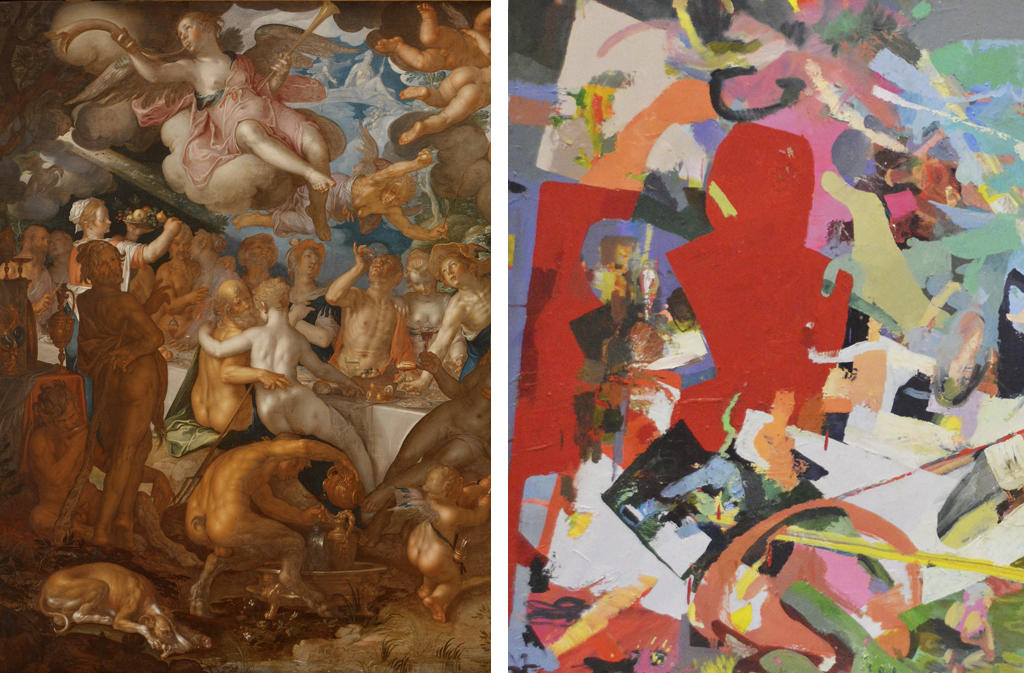I needn’t have done undergraduate coursework in neuroscience to report that the human brain is under assault by information, vastly more of it than any of us can hope to process meaningfully. Few things do I already know more intimately. That said, here’s my synopsis from the academy: We each get a finite amount of currency called “attention.” Our survival depends on how well we allocate it, what we deem crucial to attend to and, equally important, what we neglect. Effectively gambles, these decisions determine not only the direction but the very substance of our existence. We’re still uncertain about the mechanism driving these choices, and the nature of attention itself, despite active cognitive and neuroscience research.
While I struggled to keep my head during my chosen field’s struggle to codify it, a 16th-century Dutch painting by Joachim Antonis Wtewael in the RISD Museum’s collection managed to penetrate my brooding.

Joachim Antonisz Wtewael, “The Marriage of Peleus and Thetis”, 1610. Mary B. Jackson Fund
The Marriage of Peleus and Thetis caught my attention by deliberately diverting it. Every inch of its swarming surface pleads to be the center. The bride and groom (two faces under an arm holding up a platter) occupy less surface area than the buttocks of a centaur pouring himself a drink in the foreground. Wtewael abandons us, along with the wedding guests, to decipher this uniform lush madness.
But the universe inhabited by Peleus and Thetis is a deterministic one. We have only to turn to mythology to find out that their fate rests in a piece of fruit still in the hand of an old woman emerging from the center left. Miffed at not receiving an invitation to the wedding, Eris, goddess of discord, drops a golden apple labeled “for the fairest” into the crowd. The ensuing squabble over the apple’s rightful recipient triggers a series of events culminating in the Trojan War.
My omniscience only makes me identify with the wedding guests more intensely. In this instant, the hierarchy between epic narrative and decoration collapses, leaving every detail with the potential to recede or revolutionize. The apple has not yet fallen from Eris’s hand. Nothing can be elevated nor omitted.

“The Marriage, Distillation #1”
Setting my attention on something whose essence was irreducibility, I decided to try to do what Wtewael eloquently renders futile: boil down his painting. Borrowing loosely from experimental paradigms I’d encountered in class, I gave myself a finite amount of time and the task of “summarizing” Wtewael’s cacophonous masterpiece. I performed three “distillations,” beginning with The Marriage of Peleus and Thetisand using the results of the previous distillation as the substrate for the next.

“The Marriage, Distillation #2”
These are my attempts to identify the essential and salvage it. In a crunch, I’ve grabbed at shape, scale, density, figuration, abstraction, pattern, semantics, etc. With every round the results veer further away from impartial summaries and toward my own distractions. In the last, I grew impatient with the notion that distillation had to be reductive, and I began siphoning from the original painting again.
The results are mixed, if not entirely inconclusive: I remain uncertain about how to tell the difference between a universe with a preexisting “point” and one in which I generate it myself. I suspect that the existence of a painting depicting the instant just before fate sets in could constitute evidence of such an instant. I contend that there are moments in which nothing matters more than anything else.

“The Marriage, Distillation #3”
Josephine Devanbu
Brown/RISD Dual Degree Program, 2015
